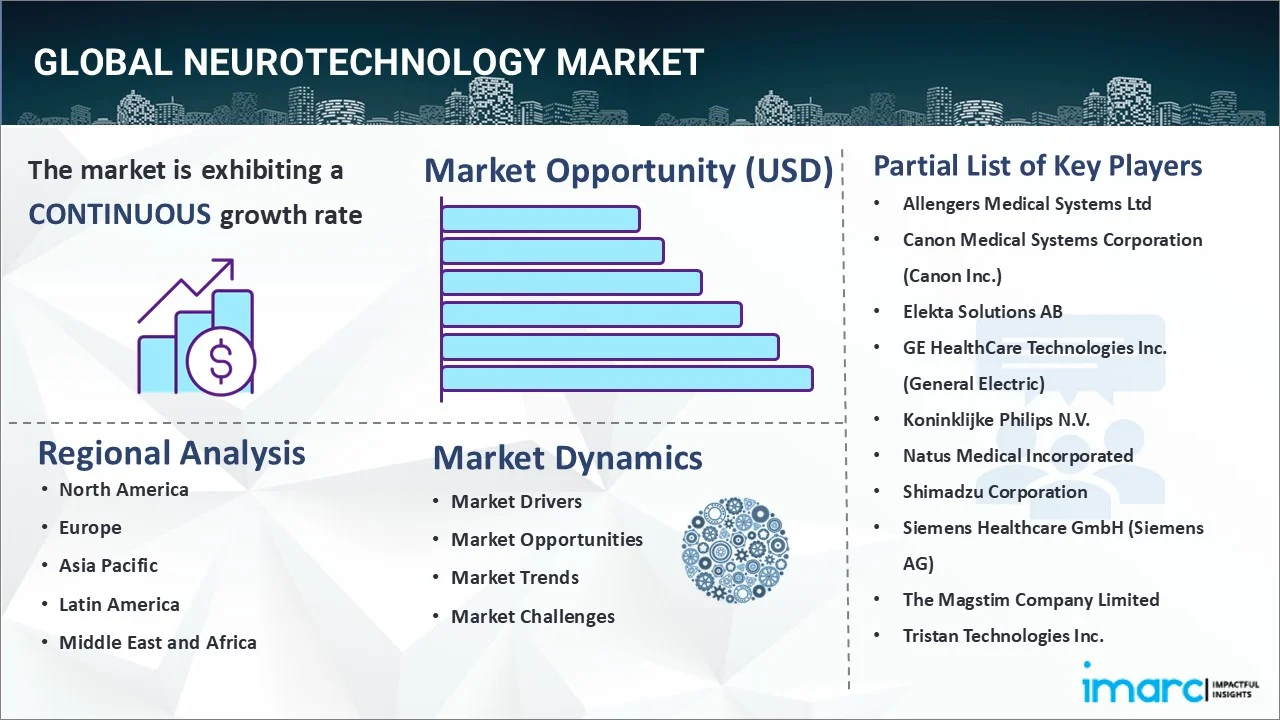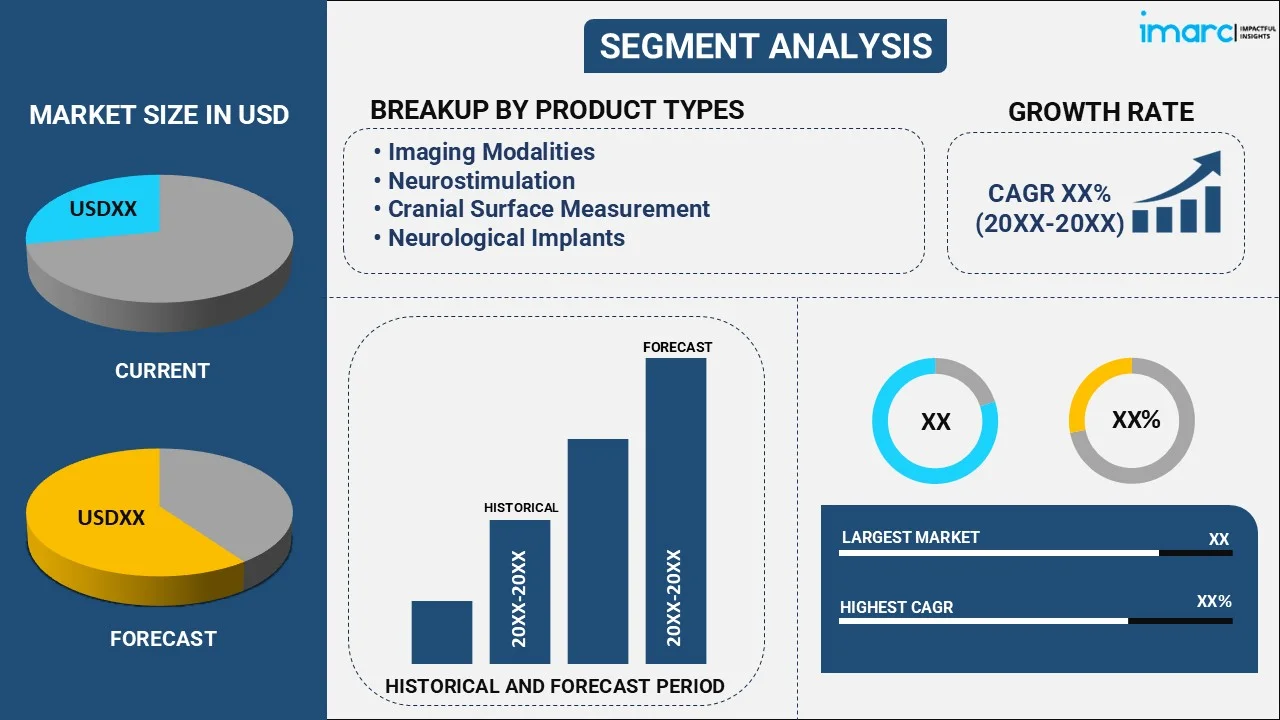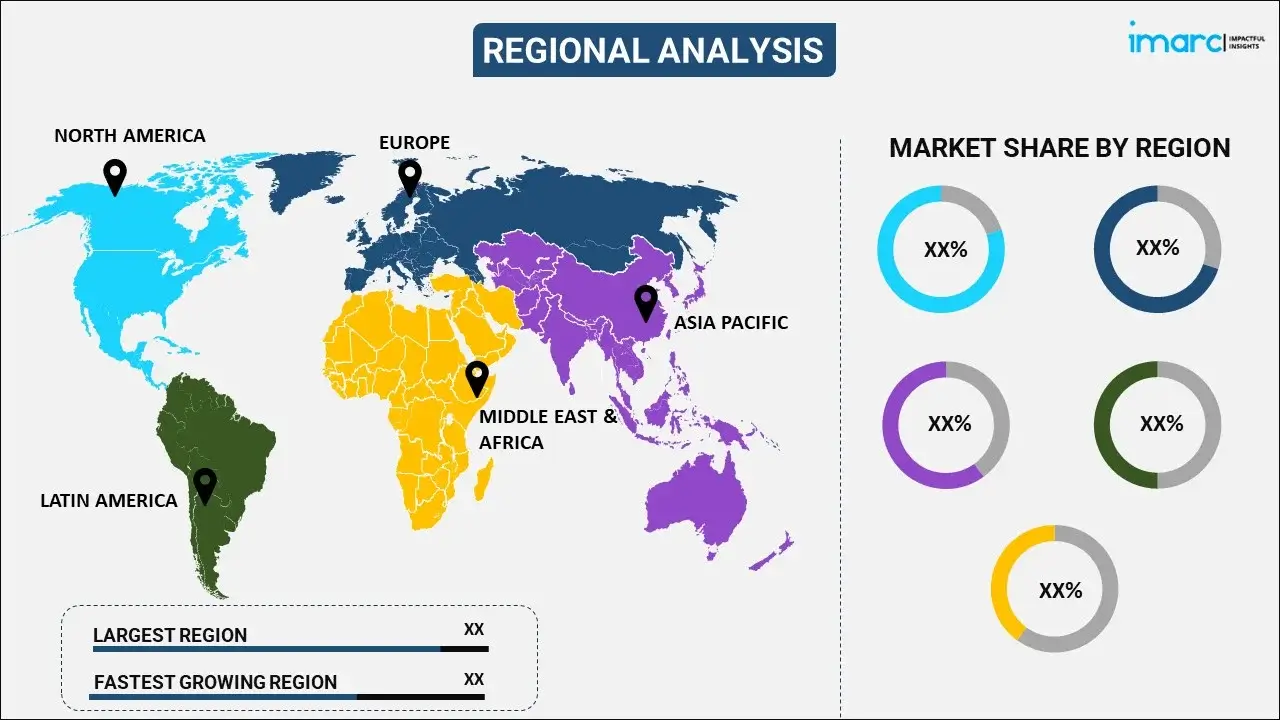
Neurotechnology Market Report by Product Type (Imaging Modalities, Neurostimulation, Cranial Surface Measurement, Neurological Implants), End User (Hospitals, Clinics, Diagnostic Centres, Ambulatory Surgical Centres), and Region 2025-2033
Global Neurotechnology Market:
The global neurotechnology market size reached USD 12.6 Billion in 2024. Looking forward, IMARC Group expects the market to reach USD 31.1 Billion by 2033, exhibiting a growth rate (CAGR) of 10.01% during 2025-2033. The rising prevalence of malignant central nervous system (CNS), the implementation of supportive government policies, and the introduction of wearable neurotechnologies, represent some of the key factors driving the market.
|
Report Attribute
|
Key Statistics
|
|---|---|
|
Base Year
|
2024 |
|
Forecast Years
|
2025-2033
|
|
Historical Years
|
2019-2024
|
| Market Size in 2024 | USD 12.6 Billion |
| Market Forecast in 2033 | USD 31.1 Billion |
| Market Growth Rate (2025-2033) | 10.01% |
Neurotechnology Market Analysis:
- Major Market Drivers: The rising prevalence of malignant central nervous system (CNS) disorders, such as strokes, epilepsy, Parkinson’s and Alzheimer’s disease, multiple sclerosis, and autism, is one of the primary factors strengthening the market growth. In addition to this, the widespread utilization of neurotechnology to monitor and diagnose psychiatric disorders, such as depression, anxiety, schizophrenia, and obsessive-compulsive disorder (OCD), is acting as another growth-inducing factor.
- Key Market Trends: The implementation of supportive government policies to educate the masses and provide access to high-quality healthcare facilities is positively influencing the market growth. Moreover, the rising geriatric population, extensive research and development (R&D) activities, and the growing consumer awareness and acceptance of mental health issues, are anticipated to drive the market growth.
- Competitive Landscape: Some of the prominent neurotechnology market companies include Allengers Medical Systems Ltd, Canon Medical Systems Corporation (Canon Inc.), Elekta Solutions AB, GE HealthCare Technologies Inc. (General Electric), Koninklijke Philips N.V., Natus Medical Incorporated, Shimadzu Corporation, Siemens Healthcare GmbH (Siemens AG), The Magstim Company Limited, and Tristan Technologies Inc., among many others.
- Geographical Trends: According to the neurotechnology market dynamics, North America dominates the overall market. Disorders like Alzheimer's disease, Parkinson's, epilepsy, and stroke are on the rise in North America due to the aging population. These conditions drive demand for neurotechnology solutions for diagnosis, treatment, and rehabilitation.
- Challenges and Opportunities: The high cost of developing and implementing neurotechnology is hampering the market’s growth. However, as mental health awareness grows, there is increasing interest in neurotechnological solutions such as transcranial magnetic stimulation (TMS) and neurofeedback for conditions like depression, PTSD, and anxiety. The mental health crisis has created a huge opportunity for these therapies, especially as alternatives to medication.

Neurotechnology Market Trends:
Rising Prevalence of Neurological Disorders
Neurological disorders such as Alzheimer’s disease, Parkinson’s disease, epilepsy, multiple sclerosis, and stroke are becoming more common. According to a study published by The Lancet Neurology, more than three billion individuals worldwide suffered from a neurological disorder in 2021. Also, according to an article published by the Alzheimer’s Association, in 2024, an estimated 6.9 million people in the United States aged 65 and older were living with Alzheimer's. The increasing prevalence of these diseases is driving the demand for neurotechnology. These factors are expected to propel the neurotechnology market share in the coming years.
Adoption of Wearable Devices
Consumers are becoming more aware of brain health, mental well-being, and cognitive enhancement. Wearable neurotechnology, such as brain-computer interfaces (BCIs) and neurostimulators, offers non-invasive methods to monitor and potentially enhance brain function. For instance, in September 2024, Neurable Inc., a neurotechnology company specializing in AI-powered tools, and premium audio brand Master & Dynamic introduced the MW75 Neuro, smart headphones equipped with Neurable's brain-computer interface (BCI) technology to help users gain deeper insights into their cognitive health, manage burnout, and improve daily performance. These factors further positively influence the neurotechnology market forecast.
Technological Innovations
Integrating artificial intelligence (AI) and machine learning (ML) into neurotechnology is enhancing diagnostic accuracy and enabling predictive modeling for neurological diseases. These tools can analyze large datasets from brain imaging or neural data, improving the precision of treatments. For instance, in March 2024, Philips and Synthetic MR partnered to launch an AI-based quantitative brain imaging system to improve the diagnosis of neurological illnesses. This collaboration intends to transform the diagnosis and analysis of diseases like multiple sclerosis, traumatic brain injuries, and dementia, thereby boosting the neurotechnology market revenue.
Global Neurotechnology Industry Segmentation:
IMARC Group provides an analysis of the key trends in each segment of the global neurotechnology market report, along with forecasts at the global, regional, and country levels for 2025-2033. Our report has categorized the market based on product type and end user.
Breakup by Product Type:

- Imaging Modalities
- Magnetic Resonance Imaging (MRI)
- Computed Tomography (CT)
- Positron Emission Tomography (PET)
- Neurostimulation
- Transcranial Magnetic Stimulation (TMS)
- Transcranial Direct Current Stimulation (TDCS)
- Cranial Surface Measurement
- Electroencephalography (EEG)
- Magnetoencephalography (MEG)
- Neurological Implants
Imaging modalities represented the largest segment
The report has provided a detailed breakup and analysis of the neurotechnology market based on the product type. This includes imaging modalities (magnetic resonance imaging (MRI), computed tomography (CT), and positron emission tomography (PET)), neurostimulation (transcranial magnetic stimulation (TMS) and transcranial direct current stimulation (TDCS)), cranial surface measurement (electroencephalography (EEG) and magnetoencephalography (MEG)), and neurological implants. According to the report, imaging modalities represented the largest segment.
According to the neurotechnology market outlook, imaging modalities in neurotechnology play a crucial role in the understanding and treatment of neurological disorders, cognitive enhancement, and brain research. Moreover, the increasing prevalence of neurological conditions such as Alzheimer's disease, Parkinson's disease, epilepsy, and stroke is driving the need for advanced neuroimaging technologies. These modalities help in the early detection, monitoring, and treatment planning of neurological disorders.
Breakup by End User:
- Hospitals
- Clinics
- Diagnostic Centres
- Ambulatory Surgical Centres
Hospitals accounted for the largest market share
A detailed breakup and analysis of the neurotechnology market based on the end user has also been provided in the report. This includes hospitals, clinics, diagnostic centres, and ambulatory surgical centres. According to the report, hospitals accounted for the largest market share.
According to the neurotechnology market overview, the increasing global burden of neurological diseases, including Alzheimer's, Parkinson's, epilepsy, multiple sclerosis, and stroke, is a significant driver. Hospitals are investing in neurotechnologies that aid in the early diagnosis, monitoring, and treatment of these conditions, improving patient outcomes. Moreover, as the population ages, hospitals are seeing more cases of age-related neurodegenerative diseases like dementia and stroke, increasing the demand for advanced neurotechnology for diagnosis, monitoring, and care.
Breakup by Region:

- North America
- United States
- Canada
- Europe
- Germany
- France
- United Kingdom
- Italy
- Spain
- Others
- Asia Pacific
- China
- Japan
- India
- South Korea
- Australia
- Indonesia
- Others
- Latin America
- Brazil
- Mexico
- Others
- Middle East and Africa
North America was the largest market for neurotechnology
The report has also provided a comprehensive analysis of all the major regional markets, which include North America (the United States and Canada); Europe (Germany, France, the United Kingdom, Italy, Spain, and others); Asia Pacific (China, Japan, India, South Korea, Australia, Indonesia, and others); Latin America (Brazil, Mexico, and others); and the Middle East and Africa. According to the report, North America was the largest market for neurotechnology.
According to the neurotechnology market statistics, some of the factors driving the North America neurotechnology market included the rising prevalence of CNS disorders, supportive government policies, and rapid technological advancements. North America, particularly the U.S. and Canada, has a large aging population. For instance, according to the Population Reference Bureau, the number of people in the United States aged 65 and older is expected to rise from 58 million in 2022 to 82 million by 2050 (a 47% increase), with the 65-and-over age group accounting for 17% to 23% of the overall population. As people age, they are more likely to suffer from neurodegenerative diseases such as Alzheimer's, Parkinson's, and dementia. This increases the demand for neurotechnology solutions to diagnose, monitor, and treat these conditions. Moreover, conditions such as stroke, epilepsy, multiple sclerosis, and traumatic brain injuries are on the rise in North America. This drives demand for neurodiagnostic tools, neuromodulation devices, and rehabilitation technologies in hospitals and healthcare settings.
Competitive Landscape:
The market research report has provided a comprehensive analysis of the competitive landscape. Detailed profiles of all major market companies have also been provided. Some of the key players in the market include:
- Allengers Medical Systems Ltd
- Canon Medical Systems Corporation (Canon Inc.)
- Elekta Solutions AB
- GE HealthCare Technologies Inc. (General Electric)
- Koninklijke Philips N.V.
- Natus Medical Incorporated
- Shimadzu Corporation
- Siemens Healthcare GmbH (Siemens AG)
- The Magstim Company Limited
- Tristan Technologies Inc.
(Please note that this is only a partial list of the key players, and the complete list is provided in the report.)
Neurotechnology Market Recent Developments:
- September 2024: Neurable Inc., a neurotechnology company specializing in AI-powered tools, and premium audio brand Master & Dynamic introduced the MW75 Neuro, smart headphones equipped with Neurable's brain-computer interface (BCI) technology to help users gain deeper insights into their cognitive health, manage burnout, and improve daily performance.
- September 2024: Elemind introduced the first-of-its-kind neurotechnology headband for sleep. It is intended to help people fall asleep faster and return to sleep quickly if they awaken.
- March 2024: Philips and Synthetic MR partnered to launch an AI-based quantitative brain imaging system to improve the diagnosis of neurological illnesses. This collaboration intends to transform the diagnosis and analysis of diseases like multiple sclerosis, traumatic brain injuries, and dementia.
Neurotechnology Market Report Scope:
| Report Features | Details |
|---|---|
| Base Year of the Analysis | 2024 |
| Historical Period | 2019-2024 |
| Forecast Period | 2025-2033 |
| Units | Billion USD |
| Scope of the Report | Exploration of Historical Trends and Market Outlook, Industry Catalysts and Challenges, Segment-Wise Historical and Predictive Market Assessment:
|
| Product Types Covered |
|
| End Users Covered | Hospitals, Clinics, Diagnostic Centres, Ambulatory Surgical Centres |
| Regions Covered | Asia Pacific, Europe, North America, Latin America, Middle East and Africa |
| Countries Covered | United States, Canada, Germany, France, United Kingdom, Italy, Spain, China, Japan, India, South Korea, Australia, Indonesia, Brazil, Mexico |
| Companies Covered | Allengers Medical Systems Ltd, Canon Medical Systems Corporation (Canon Inc.), Elekta Solutions AB, GE HealthCare Technologies Inc. (General Electric), Koninklijke Philips N.V., Natus Medical Incorporated, Shimadzu Corporation, Siemens Healthcare GmbH (Siemens AG), The Magstim Company Limited, Tristan Technologies Inc., etc. |
| Customization Scope | 10% Free Customization |
| Post-Sale Analyst Support | 10-12 Weeks |
| Delivery Format | PDF and Excel through Email (We can also provide the editable version of the report in PPT/Word format on special request) |
Key Questions Answered in This Report:
- How has the global neurotechnology market performed so far, and how will it perform in the coming years?
- What are the drivers, restraints, and opportunities in the global neurotechnology market?
- What is the impact of each driver, restraint, and opportunity on the global neurotechnology market?
- What are the key regional markets?
- Which countries represent the most attractive neurotechnology market?
- What is the breakup of the market based on the product type?
- Which is the most attractive product type in the neurotechnology market?
- What is the breakup of the market based on the end user?
- Which is the most attractive end user in the neurotechnology market?
- What is the competitive structure of the global neurotechnology market?
- Who are the key players/companies in the global neurotechnology market?
Key Benefits for Stakeholders:
- IMARC's report offers a comprehensive quantitative analysis of various market segments, historical and current market trends, market forecasts, and dynamics of the neurotechnology market from 2019-2033.
- The research study provides the latest information on the market drivers, challenges, and opportunities in the global neurotechnology market.
- The study maps the leading, as well as the fastest-growing, regional markets. It further enables stakeholders to identify the key country-level markets within each region.
- Porter's five forces analysis assists stakeholders in assessing the impact of new entrants, competitive rivalry, supplier power, buyer power, and the threat of substitution. It helps stakeholders to analyze the level of competition within the neurotechnology industry and its attractiveness.
- The competitive landscape allows stakeholders to understand their competitive environment and provides insight into the current positions of key players in the market.
Need more help?
- Speak to our experienced analysts for insights on the current market scenarios.
- Include additional segments and countries to customize the report as per your requirement.
- Gain an unparalleled competitive advantage in your domain by understanding how to utilize the report and positively impacting your operations and revenue.
- For further assistance, please connect with our analysts.
 Request Customization
Request Customization
 Speak to an Analyst
Speak to an Analyst
 Request Brochure
Request Brochure
 Inquire Before Buying
Inquire Before Buying




.webp)




.webp)












